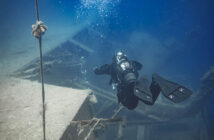A diving helmet has played a role on dry land, as well as in the water. Its inventors, brothers John and Charles Deane, patented what they called a “Smoke Helmet” in 1823. It enabled fire fighters to work in smoke-filled areas.
In the early 1820s in England, some horses were trapped in a stable fire. John put a medieval knight’s helmet on his head, had air pumped by hose from fire fighters’ water pump into the helmet, went into the inferno and saved all the horses.
His device consisted of a copper helmet, a leather garment, flexible collar and a long leather hose attached to the rear of the helmet that supplied air. Originally, it was pumped by a double bellows. The breathed air escaped via short pipe. The next step was to make it into a diving tool.
In 1829 the Deanes tried out their under-water invention, thereby launching the diving industry. That quickly morphed into diving for salvage. John Dean and diving friend George Bell brought up cannons from a wreck in 1830.
The wreck of the Mary Rose was discovered when a fishing net snagged on it. John and partner William Edwards, recovered some timbers, guns, longbows and other ititems from the ship, long before that was forbidden. The location of the shipwreck was forgotten after Deane stopped work on the site of the shipwreck in 1840.
George Hall collaborated with the Deane brothers in developing their diving apparatus. He taught the Royal Sappers & Miners and Royal Engineers to dive during the salvage of the Royal George, in 1839-40.
Deane gave a series of lectures in 1847 on “diving and submarine operations.” Charles and John Deane displayed their invention in 1851.








